The radiation of the sun - solar radiation - is the main source of thermal energy received by the earth’s surface and atmosphere. Earth receives from the Sun 1.36-10 24 fecesheat per year. This amount would be enough to melt a layer of ice 35 thick. cm, completely covering the Earth at 0 °.
The flow of thermal radiant energy of the Sun, reaching the Earth's atmosphere, is more constant. Its intensity is 1.98 feces / cm 2 mincalled solar constant.As was established earlier, the amount of solar radiation received by a surface depends on the angle of incidence of the rays. Since the height of the Sun changes during the year and day, the angle of incidence of the sun’s rays on the earth’s surface and, consequently, the amount of solar heat produced also changes.
Radiation coming to the earth’s surface directly from the Sun is called straight.Passing through the atmosphere, solar radiation is partly absorbed, turning into thermal energy. Meeting with gas molecules and particles suspended in the atmosphere, the sun's rays deviate from the straight direction and scatter. This radiation is called scattered.It causes scattered daylight.
The amount of absorbed and scattered radiation depends on the thickness of the atmosphere through which the sun's rays pass, and on its transparency. Atmospheric transparency is variable and depends on the content of water vapor and suspended particles in the air.
All solar radiation coming to the earth’s surface, direct and diffuse, is called totalradiation. Its intensity is expressed by the formula
where I - the intensity of direct radiation, i - intensity of diffuse radiation, h - the height of the sun.
The ratio between direct and diffuse radiation varies depending on cloudiness, dustiness of the atmosphere and the height of the sun. With a clear sky, the fraction of scattered radiation does not exceed 10%; with a cloudy one, the scattered radiation can be more direct. At a low altitude of the sun, the total radiation consists almost entirely of the scattered radiation.
The distribution of total radiation over the earth's surface is not strictly zonal, since it depends on cloudiness and atmospheric transparency. In the cloudless tropical desert, the annual amount of total radiation reaches 200-220 kcal / cm 2in the polar countries, its value drops to 60 kcal / cm 2.
Solar radiation, falling on the earth's surface, is partially absorbed in the upper layer of soil or water and is partially reflected back into the atmosphere. The ratio of the amount of radiation reflected from the surface to the amount of radiation falling on this surface is called albedo. Albedo depends on color, moisture, roughness and other surface properties. Fresh snow has an albedo of more than 80%, the upper surface of clouds is 50-75%, the desert is 30-35%, meadow vegetation is about 20%, forest is about 15%, freshly plowed arable land is less than 10%. The albedo of the water surface varies from 2 to 80%, depending on the height of the sun and waves.
The higher the temperature of the radiating body, the shorter the wavelength of its radiation. Therefore, solar radiation is shortwave (from 0.1 to 4 micron)and terrestrial - long-wave (from 4 to 100 mk).Earth radiation is largely retained by the atmosphere (water vapor, carbon dioxide, ozone). Absorbing part of the solar and terrestrial radiation, the atmosphere radiates thermal energy into the world space and to the earth's surface. The latter is called counter radiation. The difference between the radiation of the earth’s surface and counter-radiation determines the actual heat loss of the earth’s surface and is called effective radiation.The ability of the atmosphere to transmit the shortwave radiation of the Sun and to delay the longwave radiation of the Earth is called greenhouse effect.Due to the greenhouse effect, the average temperature of the earth's surface is 38 ° higher than it would have been without the atmosphere.
The earth's surface simultaneously receives and gives off radiation. The difference between the arrival of radiation (absorbed by the total radiation) and its consumption (effective radiation) is called radiation balance ground surface. Radiation balance is determined from the equation
![]()
where BUT- albedo 1 e- effective radiation.
The radiation balance for the whole Earth is positive, except for the ice plates of Antarctica and Greenland. At sea it is more than on land, since the albedo of land is higher than the sea. A positive value of the radiation balance does not mean that the earth’s surface is continuously heated. The excess of absorbed radiation is balanced by the transfer of heat into the air and the consumption of heat for the evaporation of water.
Part of the solar radiation is visible light. Thus, the Sun is for the Earth, but also for the light that is important for life on our planet.
The radiant energy of the Sun turns into heat partly in the atmosphere itself, but mainly on the earth's surface, where it goes to heat the upper layers of soil and water, and from them to the air. The heated earth's surface and the heated atmosphere in turn emit invisible infrared radiation. Giving radiation to the world space, the earth's surface and atmosphere are cooled.
Experience shows that the average annual temperatures of the Earth’s surface and atmosphere at any point on Earth vary little from year to year. If we consider the temperature conditions on Earth for long, long-term periods of time, then we can accept the hypothesis that the Earth is in thermal equilibrium: the arrival of heat from the Sun is balanced by its loss into space. But since the Earth (with the atmosphere) receives heat by absorbing solar radiation, and loses heat by its own radiation, the thermal equilibrium hypothesis simultaneously means that the Earth is in radiant equilibrium: the inflow of short-wave radiation to it is balanced by the return of long-wave radiation to world space .
What is the spectral composition of solar radiation? What is the spectral composition of the radiation of the Earth?
Visible light occupies a narrow range of wavelengths. However, in this interval is half of all solar radiant energy. Infrared radiation accounts for 44%, and ultraviolet radiation accounts for 9% of all radiant energy.
The distribution of energy in the spectrum of solar radiation before it enters the atmosphere is currently known quite well due to measurements from satellites.
The upper layers of soil and water, snow cover and vegetation emit longwave radiation themselves; this terrestrial radiation is more often called self-radiation of the earth's surface.
What is meant by the solar constant? How does it change over the years at the upper atmosphere?
Unscattered and unabsorbed in the atmosphere of direct solar radiation reaches the earth's surface. A small proportion of it is reflected from it, and most of the radiation is absorbed by the earth’s surface, as a result of which the earth’s surface is heated. A part of the scattered radiation also reaches the earth's surface, is partially reflected from it and partially absorbed by it. Another part of the scattered radiation goes up into the interplanetary space.
What is called direct solar radiation?Radiation coming to the earth's surface directly from the solar disk is called direct solar radiation. Solar radiation spreads from the Sun in all directions. But the distance from the Earth to the Sun is so great that direct radiation falls on any surface on Earth in the form of a beam of parallel rays emanating from infinity. It is easy to understand that the maximum amount of radiation under given conditions is received by a unit of area located perpendicular to the sun's rays.
What changes occur with solar radiation when it enters the atmosphere?
Transformations of the energy of solar radiation after its absorption on the earth’s surface and in A. constitute Heat balance Of the earth. The main source of heat for A. is the earth's surface, which absorbs most of the solar radiation. Since the absorption of solar radiation in A. is less than the loss of heat from A. into world space by long-wave radiation, the radiative heat consumption is compensated by the influx of heat to A. from the earth's surface in the form of turbulent heat exchange and the influx of heat as a result of condensation of water vapor into A. the value of condensation throughout A. is equal to the amount of precipitation, as well as the amount of evaporation from the earth's surface, the arrival of condensation heat in A. is numerically equal to the amount of heat required for evaporation on the surface of the Earth.
Some of the energy of solar radiation is spent on maintaining the general circulation of A. and other atmospheric processes, but this part is insignificant compared to the main components of the heat balance.
What substances are the strongest absorbers of solar radiation and in which parts of the spectrum?
At the upper limit of the atmosphere solar radiation comes in the form of direct radiation. About 30% of direct solar radiation incident on the Earth is reflected back into outer space. The remaining 70% enters the atmosphere.
About 26% of the total solar radiation energy is converted into scattered radiation in the atmosphere. About
2/3 of the scattered radiation comes then to the earth's surface. But it will be a special kind of radiation, significantly different from direct radiation. First, the scattered radiation comes
to the earth’s surface, not from the solar disk, but from the whole of the firmament.
Secondly, the scattered radiation is different from the direct spectral composition, since the rays of different wavelengths are scattered to different degrees.
The laws of scattering are significantly different depending on the ratio of the wavelength of solar radiation and the size of scattering particles.ozone is a strong absorber of solar radiation. It absorbs ultraviolet and visible solar radiation. Despite the fact that its content in the air is very small, it absorbs ultraviolet radiation so strongly in the upper atmosphere that in the solar spectrum at the earth's surface waves shorter than 0.29 microns are not observed at all.
Carbon dioxide (carbon dioxide) strongly absorbs radiation in the infrared region of the spectrum, but its content in the atmosphere is still small, therefore its absorption of direct solar radiation is generally small.
How is the scattering of solar radiation? What phenomena are associated with this?
Scattering is a fundamental physical phenomenon of the interaction of light with matter. It can occur at all wavelengths of the electromagnetic spectrum, depending on the ratio of the size of the scattering particles to the wavelength of the incident radiation. When scattering a particle that is on the path of propagation of an electromagnetic wave, continuously "extracts" energy from the incident wave and re-emits it in all directions. Thus, a particle can be considered as a point source of scattered energy. Sunlight coming from the solar disk, passing through the atmosphere, changes its color due to scattering. The scattering of solar radiation in the atmosphere is of great practical importance, since it creates diffused light in the daytime.
- What is called the atmosphere? What do you know about the energy sources of atmospheric processes?
Practically the only source of energy for all physical processes developing in Austria is solar radiation. The main feature of the radiation regime A. - the so-called. greenhouse effect: A. weakly absorbs shortwave solar radiation (most of it reaches the earth’s surface), but delays the longwave (wholly infrared) thermal radiation of the earth’s surface, which significantly reduces the Earth’s heat transfer to space and increases its temperature.
What is the weather? What are the magnitudes and phenomena of the weather? Weather - a set of values of meteorological elements and atmospheric phenomena observed at a certain point in time at a particular point in space. The term “weather” refers to the current state of the atmosphere, as opposed to the concept “Climate”, which refers to the average state of the atmosphere over a long period of time. If there are no specifications, then the term "weather" means the weather on Earth. Weather phenomena occur in the troposphere (the lower part of the atmosphere) and in the hydrosphere.
There are periodic and non-periodic weather changes. Periodic weather changes depend on the daily and annual rotation of the Earth. Non-periodic due to the transfer of air masses. They disrupt the normal course of meteorological variables (temperature, atmospheric pressure, air humidity, etc.). Disagreements of the phase of periodic changes with the nature of non-periodic lead to the most drastic changes weather
There are two types of meteorological information:
Primary weather information obtained from meteorological observations.
weather information in the form of various reports, synoptic maps, upper-air charts, vertical sections, cloud maps, etc.
The usual weather phenomena on Earth are wind, clouds, precipitation (rain, snow, hail, etc.), fog, thunderstorms, dust storms and blizzards. More rare events include natural disasters such as tornadoes and hurricanes. Almost all weather phenomena occur in the troposphere (lower part of the atmosphere).
Differences in the physical properties of air masses arise due to changes in the angle of incidence of sunlight depending on the latitude and remoteness of the region from the oceans. The large temperature difference between arctic and tropical air is the reason for the presence of high-altitude jet streams. The baric formations in the middle latitudes, such as extratropical cyclones, are formed during the development of waves in the zone of the high-altitude jet stream. Since the axis of the Earth is inclined relative to the plane of its orbit, the angle of incidence of sunlight depends on the time of year. On average, the annual temperature on the surface of the Earth varies within ± 40 ° C. For hundreds of thousands of years, the change in the Earth’s orbit affects the amount and distribution of solar energy on the planet, determining the long-term climate.
The difference in surface temperatures in turn causes a difference in the atmospheric pressure field. The hot surface heats the air above it, expands it, reducing the pressure and density of the air. The resulting horizontal pressure gradient accelerates the air towards low pressure, creating wind. And as a result of the Coriolis effect, as the Earth rotates, the flow twists. An example of a simple weather system is coastal breezes, and a complex one is the Hadley cell.
Give a definition of climate. What is meant by local and global climate?
- What is a meteorological network? What is the observation program at meteorological stations? Meteorologist and chesky network
, a set of meteorological stations conducting observations under a single program and within strictly set time limits for studying the weather, climate and solving other applied and scientific problems.
There are analog and digital meteorological stations.
The classical (analog) weather station has:
thermometer to measure air and soil temperature
pressure gauge
hygrometer for measuring humidity
anemorumbometer (or vane) to measure wind speed and direction
precipitation gauge
pluviograph for continuous recording of precipitation for a period of liquid precipitation
thermometer for continuous recording of air temperatureThe following meteorological quantities are recorded at meteorological stations of the main type:
Air temperature at a height of 2m above the earth's surface;
Atmosphere pressure;
Humidity - the partial pressure of water vapor in the air and relative humidity;
Wind - horizontal movement of air at a height of 10 -12 m above the earth's surface (its speed is measured and the direction from which the wind blows is determined);
The amount of precipitation from the clouds, their types (rain, drizzle, snow, etc.);
Cloudiness - degree of sky coverage with clouds, types of clouds according to the international classification, height of the lower border of clouds closest to the earth's surface;
- the presence and intensity of various precipitations formed on the earth's surface and on objects (dew, frost, ice, etc.), as well as fog;Horizontal visibility is the distance at which the outlines of objects no longer differ;
Duration of sunshine;
The temperature at the surface of the soil and at several depths in the soil;
Soil surface condition;
The height and density of snow cover.
At some stations, evaporation of water from water surfaces or from soil is measured.
Meteorological and optical phenomena are also recorded: blizzards, squalls, tornadoes, haze, dust storms, thunderstorms, quiet electrical discharges, auroras, rainbows, circles and crowns around disks of stars, mirages, etc.
At the coastal meteorological stations, observations are also made on the temperature of the water and the disturbance of the water surface. The program of observations on ships differs from observations at land stations only in detail. The work program of stations with a specific production profile, for example, agrometeorological, aviation and others, includes additional observations related to the specifics of the service, the relevant sectors of the national economy (agriculture, aviation, etc.).
Not all meteorological values are observed in each observation period. For example, rainfall is measured four times a day, the height of snow cover is once a day, the density of snow is once every five or ten days, etc.
In addition to meteorological stations, there is a much more numerous network of meteorological posts where observations are made only on precipitation and snow cover, since a more dense network of observations is needed to estimate the distribution of these quantities.
The observation programs of observatories and a number of special stations also include observations of solar radiation, terrestrial radiation, and the reflective properties of the earth’s surface and water; observations of air temperature and humidity at different altitudes in the surface air layer (gradient observations); measurement of airborne dust, chemical impurities, radioactive products, etc .; atmospheric electrical observations on air ionization, i.e. over the content of electrically charged particles in it, and over measurements of the electric field of the atmosphere.
The purpose and objectives of the creation of the CPSU (decipher the abbreviation)?
WCP combines four related programs: the World Climate Research Program, the World Climate Knowledge Application Program, the World Climate Effects Research Program on Human Activities, and the World Climate Data Program. Coordination of all work on these programs is entrusted to the Bureau of the WCP specially created under the WMO Secretariat. Scientific aspects of the WCP are discussed by the Joint Scientific Committee. The committee consists of Soviet scientists, academician A. M. Obukhov and professor M. A. Petrosyants. The main directions of the planned research are determined. In particular, it is expected to study the feedback mechanism between clouds and radiation, the interaction processes of the ocean and the atmosphere, the development of a climate model and the implementation of a number of experiments. It is planned to involve the Scientific Committee for Ocean Research (SCOR), the Committee on Space Research (COSPAR), the International Association of Meteorology and Atmospheric Physics (MAMFA) in the implementation of the research program.
Much attention is paid in the VKP to improving the methods of research, expanding work on applied climatology and meeting the needs of the national economy in climate data, preparing archival materials on the climate of the globe.
World Climate Research Program (WCRP)
AND I. Tolkachev (NOC of Russia)
In 1980, the implementation of the World Climate Program (WCP) under the auspices of the World Meteorological Organization (WMO), the Intergovernmental Oceanographic Commission (IOC) of UNESCO, the International Scientific Council (ICSU) and the United Nations Environment Organization (UNEP) began. The most important element WCP is an international scientific program - the World Climate Research Program (WCRP). The research results of the WCRP program are used by the WCRP Intergovernmental Panel on Climate Change under the auspices of three international organizations: the World Meteorological Organization (WMO), the Intergovernmental Oceanographic Commission (IOC) of UNESCO and the International Scientific Council (ICSU).The main objectives of the WCRP are:
Determine climate predictability.
Determine the human impact on climate.
What science is called meteorology? Formulate the stages of the formation of meteorology as a science.
Atmospheric processes are accompanied by the redistribution of huge amounts of energy (in the end, all forms of energy are heat). For our planet, there are three potential sources of thermal energy: the radiant energy of the Sun (solar radiation), the energy of the stars and the solar energy reflected from the Moon, and finally the internal heat of the cooling down Earth, which comes to the surface as a result of tectonic processes with thermal waters, geysers, etc. The energy of the stars and the internal heat of the Earth are negligible compared with solar radiation, therefore, the radiant energy of the Sun is considered as the only source of all energy processes on Earth.
The distribution of energy in the solar spectrum over wavelengths is uneven. It can be approximated by Planck’s law. About 99% of solar energy accounts for wavelengths γ from 0.1 to 4 microns. These waves are called short. Only one percent of solar energy comes from long wavelengths (γ\u003e 4 microns). In the shortwave portion of the solar spectrum, one can distinguish ultraviolet waves (0.1–0.4 μm), visible waves (0.4–0.78 μm), and near infrared waves (0.78–4 μm). The visible portion of the solar spectrum accounts for almost half of the energy emitted by the sun. In the visible part of the spectrum the shortest purple waves, and the longest - red.
About 5% fall to the ultraviolet part, 52% to the visible part and 43% to the infrared part. In the visible part of the spectrum the shortest purple waves. The maximum solar radiation falls on the wavelength of 0.47 microns, which corresponds to the blue-blue portion of the solar spectrum. The longest waves are red.
At the Earth's surface, the ultraviolet part of the spectrum accounts for about 1%, the visible - about 40% and the infrared - about 60%. The maximum radiation here occurs at wavelengths of about 0.56 μm, which corresponds to the yellow-green part of the spectrum.
Solar radiation in the atmosphere is absorbed predominantly by ozone (ultraviolet rays), water vapor and carbon dioxide, as well as clouds and solid particles of impurities. In the solar spectrum, the Earth does not observe waves shorter than 0.29 microns.
Atmospheric air - an optically inhomogeneous medium that scatters the radiant energy of the sun. As a result, for example, illuminated places where direct sunlight does not penetrate. The scattering of radiant energy in the atmosphere occurs in two ways: on molecules and in an aerosol. The intensity of molecular and aerosol scattering is different. As a result, the percentage of rays of different wavelengths is constantly changing, changing the color of the celestial sphere, the solar disk, etc. The electromagnetic shortwave radiation of the Sun comes to the earth's surface as direct radiation, scattered and total.
5. The heat exchange of the ocean and atmosphere.
The temperature of the Earth’s surface averages 15 ° (288 K). Having such a temperature, the Earth radiates mainly long-wave infrared (thermal) radiation into the atmosphere. The wavelength, which accounts for the maximum energy, is 10 microns.
The atmosphere absorbs a significant part of the long-wave radiation of the earth's surface. The main absorbers of long-wave radiation are carbon dioxide (CO 2) and especially water (H 2 O), since there is a lot of water in the atmosphere. Clouds consist of liquid (drops), solid (crystals) and gaseous (water vapor) water. They intensively absorb the long-wave radiation of the Earth, acting as an insulating layer, like the glass walls of a greenhouse. This effect is called the greenhouse effect.
Thermal state the earth’s surface can thus be characterized by the difference between the heat absorbed and the effective radiation. This difference is called radiation balance. Radiation balance can be both positive and negative. It moves from positive daytime to negative nighttime values before sunset at altitudes of 10–15 °. The presence of snow cover increases this angle to 20–25 °. The radiation balance of the sea is 10–20% more than the land balance due to lower values of the water albedo, since the effective radiation of these surfaces is almost the same. The average long-term value of the radiation balance is zero.
Most of the solar energy is absorbed by the earth's surface, which, due to its physical inhomogeneity (ocean, land, differences in relief, cold and warm currents, etc.) heats up differently. Atmospheric air adjacent to this surface will also be heated differently. Warmer volumes of air (as lighter ones) will rise up, and colder volumes will go down. Air movements due to density differences will be turbulent. and the more intense the faster the air temperature falls with altitude. This turbulence is called thermal turbulence, or convection. Thus, heat from PP to the atmosphere is transferred along with molecular and convective heat conduction.
Influence of radiation factors on the transported cargo.
In tropical latitudes during the day the hull of the vessel as a result of absorption of solar radiation is overheating. Directly on deck ceilings, the temperature can reach 60-70 ° C. This has a noticeable effect on cargoes sensitive to high temperatures. Temperature and humidity conditions change in the holds below the deck. At night, with a negative radiation balance, the hull of the vessel may become colder than the outside air. Then the temperature of the cooling surfaces may fall below the bilge air dew point. Such fluctuations are especially great in the holds located above the waterline.
6. Temperature gradients and stratification of the atmosphere.All meteorological elements vary in space and in time, i.e. they are functions of point and time coordinates. The spatial distribution of meteorological elements is called the fields of these elements. The variability of the meteorological element in space is conveniently characterized by the gradient of this field. The gradient of a meteorological field is called the fall of a given value along the normal to the surface of an equal value of that quantity, calculated per unit distance.
For practical purposes, it is impractical to operate with spatial gradients of meteorological elements, and find their projections on the horizontal (level) surface - the horizontal gradient and the vertical axis - the vertical gradient. The vertical temperature gradient -–- is denoted by γ and the unit of measure for it is the degree of temperature per 100 m height. Horizontal temperature gradient -  measured in degrees per degree of meridian (approximately 100 km).
measured in degrees per degree of meridian (approximately 100 km).
The temperature drop with a height on average is 0.65 ° С per 100 m height. The decrease in temperature with height is explained by the presence of snow caps on the tops of the mountains, even in equatorial latitudes. This is the main reason that the absolute minimum temperature on the Earth's surface (-89 ° C) is observed precisely in the southern hemisphere, in the center of Antarctica, where the altitude above sea level is more than 4000 m. In the northern hemisphere, the absolute minimum temperature is -69 ° С . It is observed in Yakutia, approximately at sea level.
Atmosphere stratification and weather.
Provided that the underlying surface is warm and the air is cold, the temperature with a height drops rapidly (more than 1 ° C per 100 m height) vertical movements develop in the atmosphere. Such stratification (temperature distribution with height) called unstable (pic.5).
Warm air rises, thermal convection occurs. The formation and development of convective clouds with all its attendant phenomena (rainfall, hail, etc.) is possible.
Unstable stratified air in equatorial latitudes. In temperate latitudes, unstable stratification is observed in the rear parts of cyclones and anticyclones adjacent to them. Visibility there is good except for the precipitation zone.
When inversion temperature distribution with height air stratification is stable. Inversion can be formed directly at the surface of the Earth as a result of radiation cooling of the lowest layer of air, or in some layer remote from the surface of the Earth (Fig. 4). The cause of stable stratification may be the advection (horizontal transfer) of warm air mass above the cold air layer or the result of lowering and heating the air. Such a stable layer in the atmosphere forms a ceiling for convection, through which it cannot penetrate. Under the inversion accumulate impurities, condensation nuclei, water vapor, brought here by convective currents from the lower layers of the atmosphere. Inversion is the upper limit, below which layered or stratocumulus clouds form.
Atmospheric stratification will be stable and isothermal, that is, with a constant temperature with a height, and even with a drop in temperature with a height, if this drop is less than 1 ° C per 100 m height. Stable stratification impedes the development of vertical movements. In such conditions formation and development of convective clouds is impossible. In the cold season with stable stratification fogs are formed. At all times of the year, such a stratification is associated with a deterioration of visibility, an increase in the concentration of impurities in the atmosphere.
PLAN Electromagnetic radiation, the spectral composition of solar radiation, the laws of radiation, thermal and radiative equilibrium of the Earth. Solar constant, direct solar radiation, changes in solar radiation in the atmosphere and on the earth's surface, absorption and scattering of solar radiation in the atmosphere, phenomena associated with radiation scattering: diffused light, sky color, twilight and dawn, atmospheric visibility, the law of attenuation of radiation in the atmosphere , transparency coefficient, turbidity factor. The diurnal course of direct and diffuse radiation. Total radiation Reflection of radiation and albedo, Planetary albedo of the Earth Absorbed radiation. Radiation of the earth's surface, counter-radiation, effective radiation ,. "Greenhouse effect. Outgoing radiation, radiation balance of the earth's surface
Radiation transfer of electromagnetic waves in straight lines at the speed of light (300 km / s) The sun is the main source of radiation coming to the earth electromagnetic waves are oscillations propagating in space, t, e are periodic changes in electrical and magnetic forces at each point in space the wavelength-distance between neighboring maxima (minima)]] oscillation frequency v is the number of oscillations per second C = λv oscillation propagation velocity

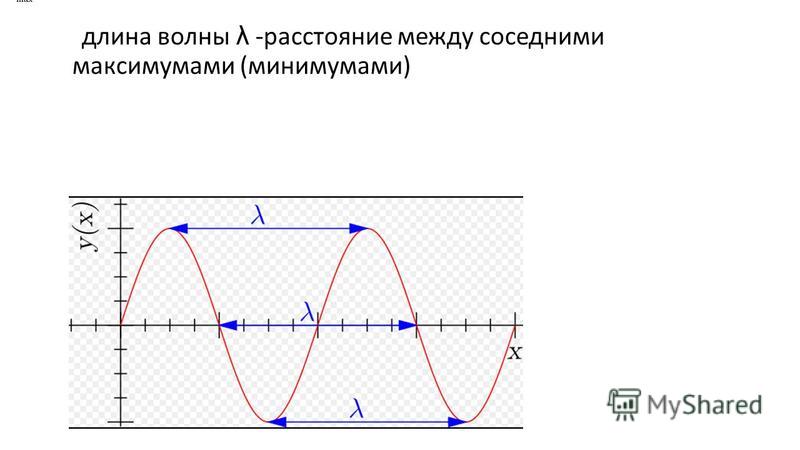
The thermal and radiative equilibrium of the Earth, the radiant energy of the Sun — practically the only source of heat for the Earth’s surface and for its atmosphere — is part of the solar radiation — visible light, the sun is the source of the radiant energy of the Sun — turns into heat partly in the atmosphere itself, but mainly on the Earth’s surface. heating the upper layers of the soil and water, and from them and the air - the heated earth's surface and the heated atmosphere - the radiation of invisible infrared radiation, transferring this radiation to world space, the earth's surface and the atmosphere Fehr cooled. thermal equilibrium - the arrival of heat is balanced by its loss; radiant equilibrium - the influx of radiation to it is balanced by the impact of radiation into global space

0.76 — up to an undefined upper limit, “title =” (! LANG: Electromagnetic Spectrum — Electromagnetic Radiation Distribution over Wavelengths Ultraviolet — 0.01-0.39 micron, invisible visible light is -0.40 (violet) -0, 76 µm (red), perceived by the eye Infrared-\u003e 0.76-up to an indefinite upper limit," class="link_thumb"> 6 !} Electromagnetic spectrum - distribution of electromagnetic radiation over wavelengths ultraviolet-0.01-0.39 microns, invisible visible light -0.40 (violet) -0.76 microns (red), perceived by the eye Infrared-\u003e 0.76-until undefined upper limit, conditionally up to 500 or 1000 microns, invisible 0.76-up to an undefined upper limit, "\u003e 0.76-up to an indefinite upper limit, conditionally up to 500 or 1000 microns, invisible"\u003e 0.76-up to an indefinite upper limit, "title =" (! LANG: Electromagnetic spectrum- distribution of electromagnetic radiation over wavelengths ultraviolet-0.01-0.39 microns, invisible visible light -0.40 (violet) -0.76 microns (red), is perceived by the Infrared eye-\u003e 0.76 to an indefinite upper limit,"> title="Electromagnetic spectrum - distribution of electromagnetic radiation over wavelengths ultraviolet-0.01-0.39 microns, invisible visible light -0.40 (violet) -0.76 microns (red), perceived by the eye Infrared-\u003e 0.76-until undefined upper limit"> !}

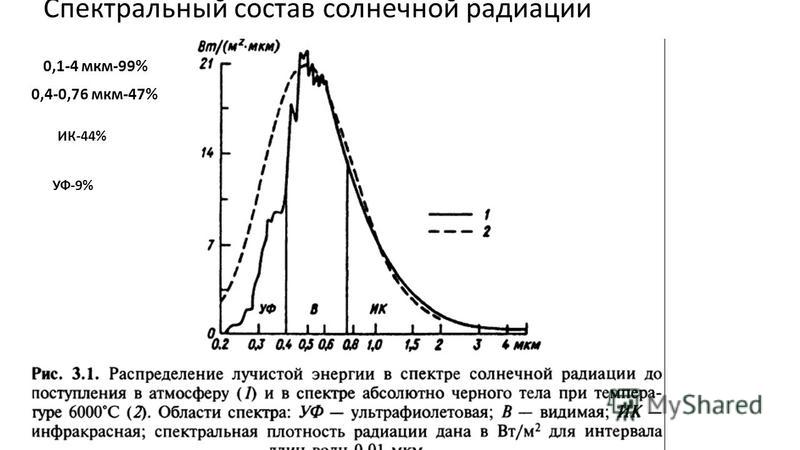
In meteorology, shortwave radiation, in the wavelength range from 0.1 to 4 microns, includes: visible light + ultraviolet radiation closest to it in wavelengths; long wavelength radiation of the earth’s surface and atmosphere with wavelengths from 4 to solar radiation by 99% - shortwave radiation
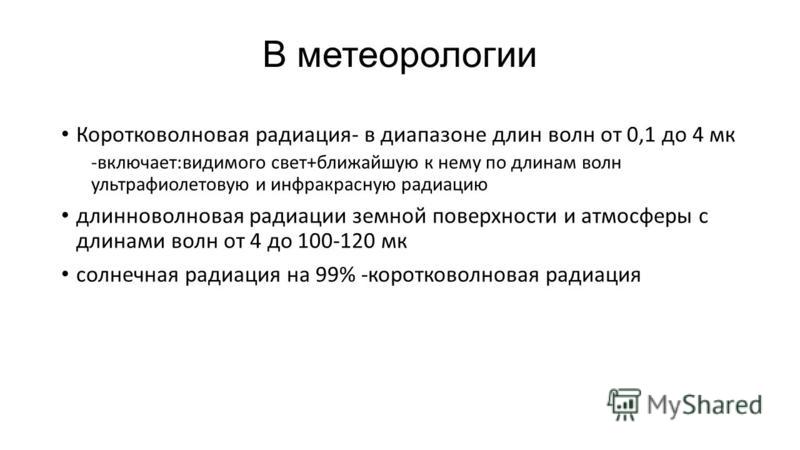
The laws of radiation Planck's law - the distribution of energy in the radiation spectrum of an absolutely black body by wavelength - energy in each wavelength interval depends only on the temperature of the radiator Kirchhoff's law of radiation: - the ratio of the emissivity of any body to its absorptivity is the same for all bodies at a given temperature for given frequency and does not depend on their form and chemical nature. The law of wine (the law of displacement): -expression of the connection of the wavelength of maximum radiation λ max of an absolutely black body with its absolute temperature T: λ max = в / T, where в is the constant Wien Stefan Boltzmann's law: -expression for the total flux of a black body depending on its absolute temperature T, where
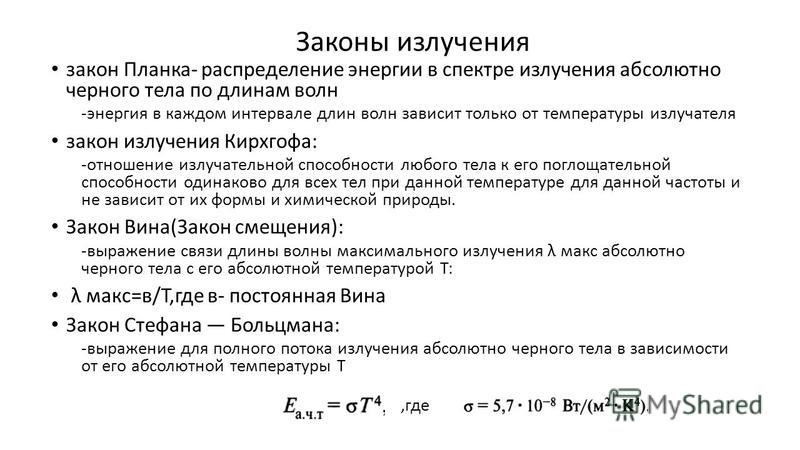
Solar constant Quantitative measure of solar radiation - energy illumination or solar radiation flux density: - amount of radiant energy falling per unit area per unit of time W / m² Solar constant-illumination of solar radiation at the upper boundary of the atmosphere, per unit of time per unit area, perpendicular to the sun's rays, with an average distance of the Earth from the Sun depends on the emissivity of the sun and the distance from the Earth to the Sun according to the data of extra-atmospheric measurements of the sun Naya constant is 1367 W / m² or 1,959 cal / cm² · min.
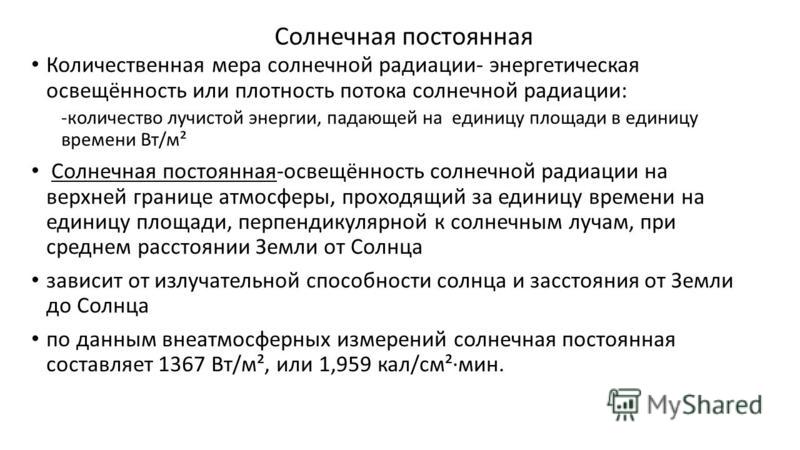
Direct solar radiation-radiation coming to the earth's surface directly from the solar disk; insolation — direct solar radiation flux to a horizontal surface — energy illumination for a certain wavelength λ — spectral density of energy illumination
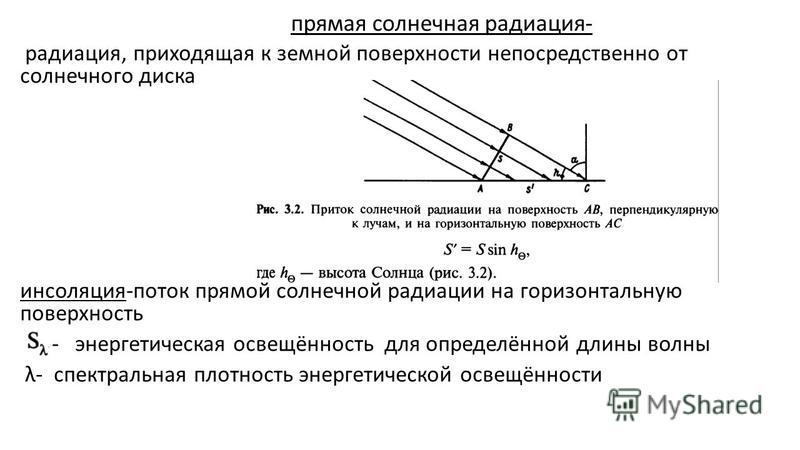
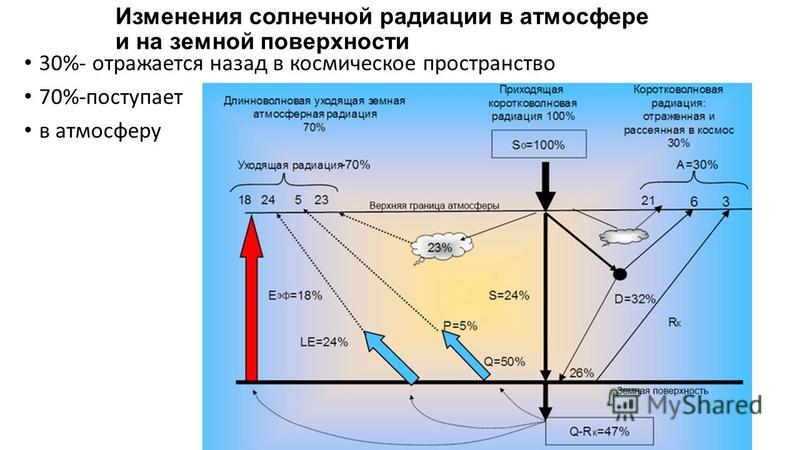
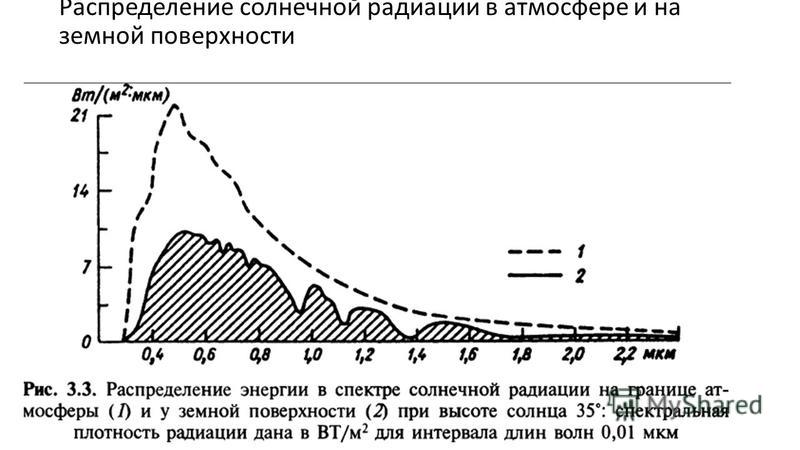
Absorption of solar radiation in the atmosphere 23% of direct solar radiation Main absorbers: water vapor — in the visible and near infrared spectral regions + aerosols — across the whole spectrum 15% of the absorbed radiation of the Cloud -5% Ozone — in the ultraviolet and visible spectral regions (up to 3% of all solar radiation) carbon dioxide gas-radiation in the infrared region of the spectrum of oxygen - in the visible and in the ultraviolet region of the spectrum of the nitrogen-ultraviolet region of the spectrum

The scattering of solar radiation in the atmosphere Scattering is a partial conversion of direct solar radiation, having a certain direction in the radiation, going in all directions occurs in an optically inhomogeneous medium: -atmospheric air containing the smallest particles of liquid and solid impurities - droplets, crystals, condensation nuclei, dust particles) - clean, free from impurities, the air due to the thermal movement of molecules; 26% of the energy of the total flux of solar radiation comes to the earth’s surface not from the solar disk, but from everything heaven its inflow arch on a horizontal surface is measured in W / m 2 rays of different wavelengths are scattered scattered to varying degrees: the smaller the size of the scattering particles, the stronger the short-seeded rays compared with longwave

Phenomena associated with radiation scattering of law-Rayleigh molecular scattering is inversely proportional to the fourth power of the wavelength. The extreme violet rays are scattered 14 times more than the extreme red. Blue sky color: blue, the human eye susceptibility is predominant (to the purple rays) black-violet the color of the sky is cloudy sky — because the droplets in the clouds are larger than the wavelength, so the entire visible spectrum (from red to violet) dissipates approximately equally 1-2–2 µm particles — diffuse reflection, the whitish color of the sky

Twilight and dawn are the reason - the sun illuminating the horizon, the high layers of the atmosphere by the sun, twilight - the illumination of the celestial vault and the illumination of the earth's surface with diffused light after the sun has already gone beyond the horizon (evening twilight), or before it rises (morning twilight) the light travels tangentially to the earth's surface, the path of light in the atmosphere becomes much larger than during the day, most of the blue and green light is scattered from direct sunlight, therefore the direct light of the sun, as well as the region illuminated by it ka and the sky near the horizon are painted in red tones. The dawn glow of the sky before sunrise and after sunset (scattering and diffraction of light) astronomical twilight — continue in the evening, until the center of the sun sets below the horizon at 18 ° civilian twilight — the time interval the course of which the sun remains below 8 °


Visibility The visibility range is the distance at which the outlines of objects in the atmosphere no longer differ. Atmospheric phenomena that impair visibility: haze, fog, haze, precipitation, blizzard, dust storm, normal visibility value (in the absence of weather phenomena) is conditionally considered 10 km. 1000 m
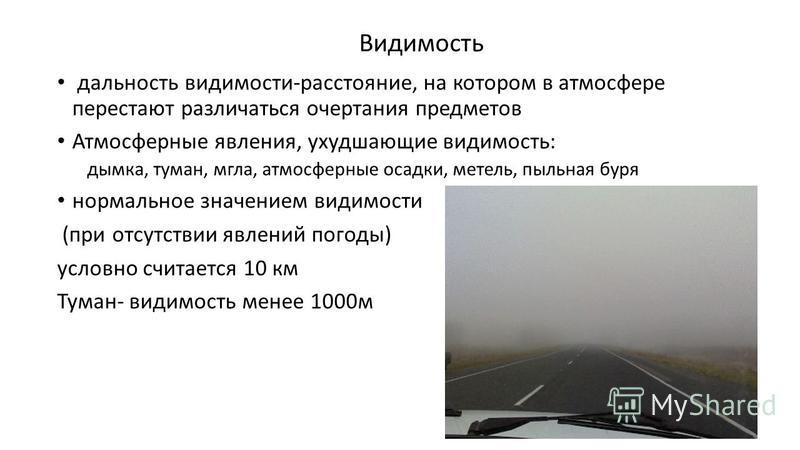
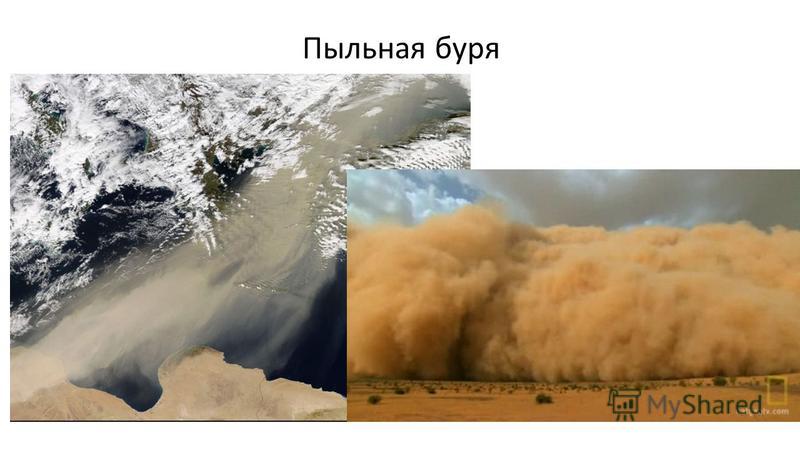
The law of radiation attenuation is attenuated in the atmosphere by absorption and scattering in proportion to 1. the radiation flux itself (the greater the flux, the more radiation will be lost under other equal conditions), 2. the number of absorbing and scattering particles in the path of the rays (depends on the length of the rays through atmosphere and air density) coefficient of transparency - the proportion of solar radiation reaching the earth's surface with a sheer drop of sunlight for an ideal atmosphere that does not contain water vapor and aerosol impurities - ok 0.9 real atmospheric conditions on the plain from 0.60 to 0.85 (more in winter than in summer) turbidity factor is a characteristic of the attenuation of solar radiation in the atmosphere, which is a ratio of the attenuation coefficients of the real and ideal atmosphere or the number of ideal atmospheres weakening the incoming radiation in the same way as a given real atmosphere value turbidity factor depends on the properties of air masses
![]()
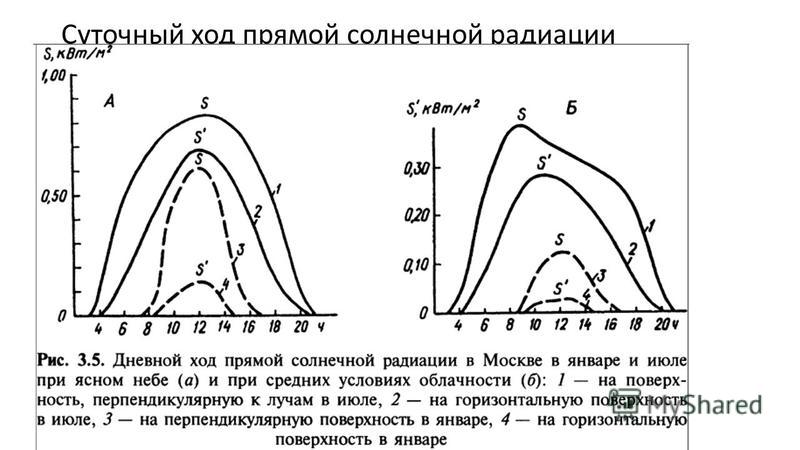
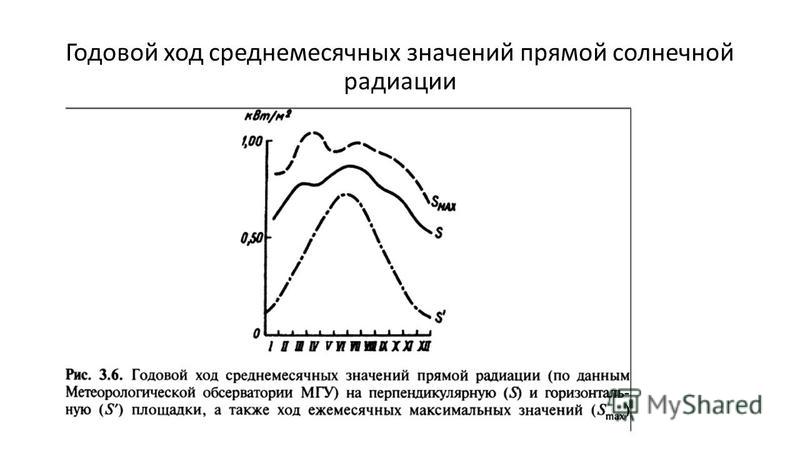
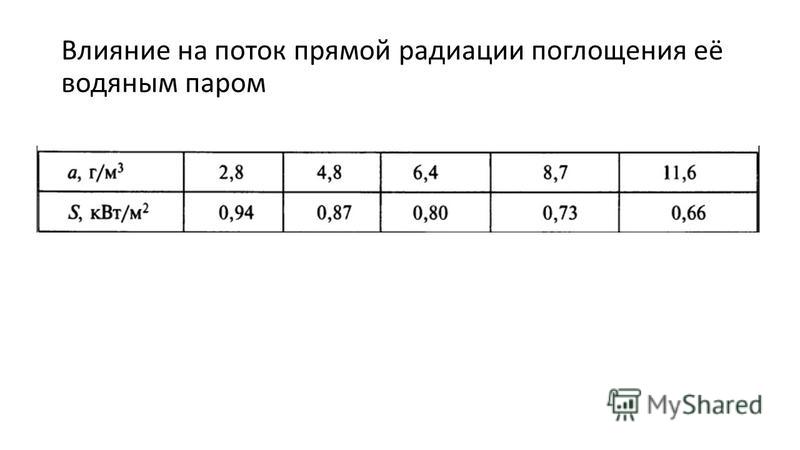

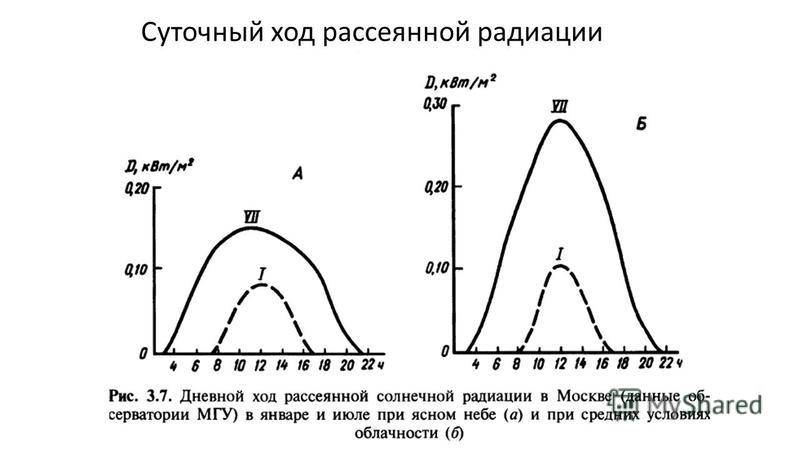
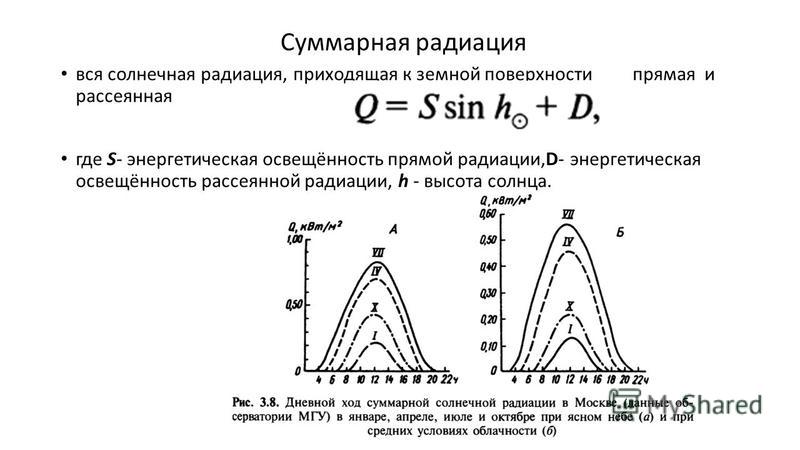
Reflection of solar radiation. Absorbed radiation. Albedo of the Earth. Reflected radiation Absorbed albedo radiation (Latin albus white) of surface A - the ratio of the amount of reflected radiation to the total amount of radiation falling on a given surface is expressed as a percentage.
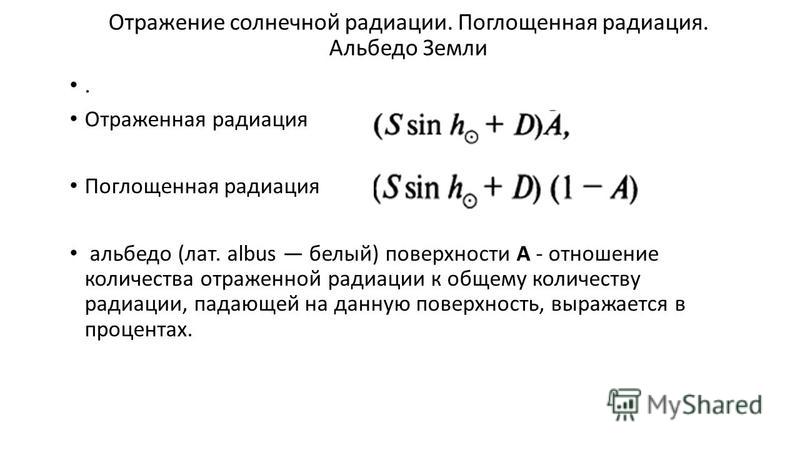
The soil albedo values are 10–30% wet chernozem — reduction to 5%, dry, light sand — growth to 40% forest, meadows, fields% fresh snow% long-lasting snow — about 50% and less. smooth water surface for direct radiation — from a few percent at high sun up to 70% at low sun — also depends on the excitement for diffuse radiation of albedo water surfaces 5–10%. world ocean surface 5-20%. the upper surface of the clouds - from a few percent to 70-80%, on average 50-60%.

Earth's albedo or planetary albedo — the ratio of this reflected and scattered solar radiation into space to the total amount of solar radiation entering the atmosphere is estimated at 31%. The main part of the Earth’s planetary albedo is a reflection of solar radiation by clouds.
 The emission of the earth's surface E s is the self-radiation of the earth's surface — the long-wavelength (infrared) spectrum (the Stefan-Boltzmann law) radiation emitted by the upper layers of soil and water, snow cover and vegetation at 15 ° or 288 K is 3.73 * 10 2 W / m. 2. The heated surface of the Earth itself radiates radiation into the atmosphere in the long-wavelength (infrared) spectrum (the Stefan-Boltzmann law) (Е s) - this is the expenditure component of the Earth’s radiation balance "transparency window" for earth radiation of 8.2-12 microns
The emission of the earth's surface E s is the self-radiation of the earth's surface — the long-wavelength (infrared) spectrum (the Stefan-Boltzmann law) radiation emitted by the upper layers of soil and water, snow cover and vegetation at 15 ° or 288 K is 3.73 * 10 2 W / m. 2. The heated surface of the Earth itself radiates radiation into the atmosphere in the long-wavelength (infrared) spectrum (the Stefan-Boltzmann law) (Е s) - this is the expenditure component of the Earth’s radiation balance "transparency window" for earth radiation of 8.2-12 microns
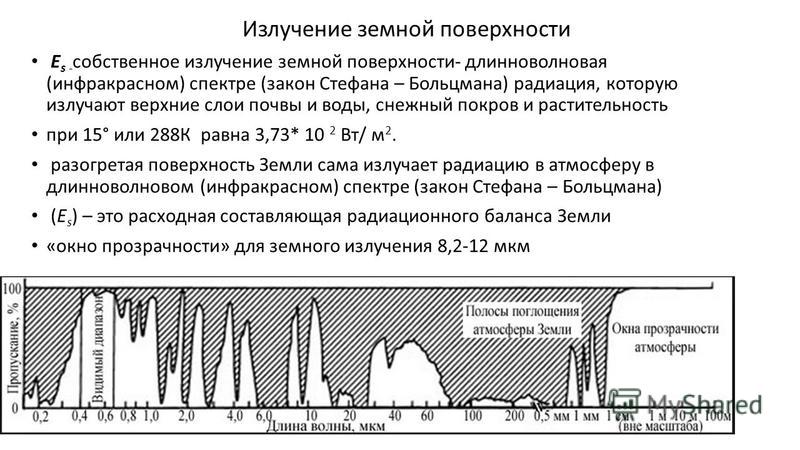
![]()
Counter-radiation Ea-atmospheric radiation (infrared) coming to the earth’s surface is absorbed by the earth’s surface almost entirely (by 90–99%) an important source of heat for the earth’s surface in addition to the absorbed solar radiation increases with increasing cloudiness on the plains (0.21- 0.28 kW / m 2)\u003e than in the mountains (0.07-0.14 kW / m 2), the maximum at the equator (0.35-42 kW / m 2) depends on the content in the atmosphere of water vapor, carbon dioxide and ozone, with a high emissivity in the infrared region of the spectrum substance in the atmosphere, the absorbent terrestrial radiation and sending the radiation counter (max. absorption 5.5- 7.0 microns) greenhouse than in the mountains (0.07–0.14 kW / m 2), the maximum at the equator (0.35–42 kW / m 2) depends on the content in the atmosphere of water vapor, carbon dioxide and ozone, which have a high emissivity in infrared region of the spectrum water vapor is the main substance in the atmosphere, absorbing terrestrial radiation and sending back radiation (max. absorption 5.5-7.0 µm) greenhouse effect 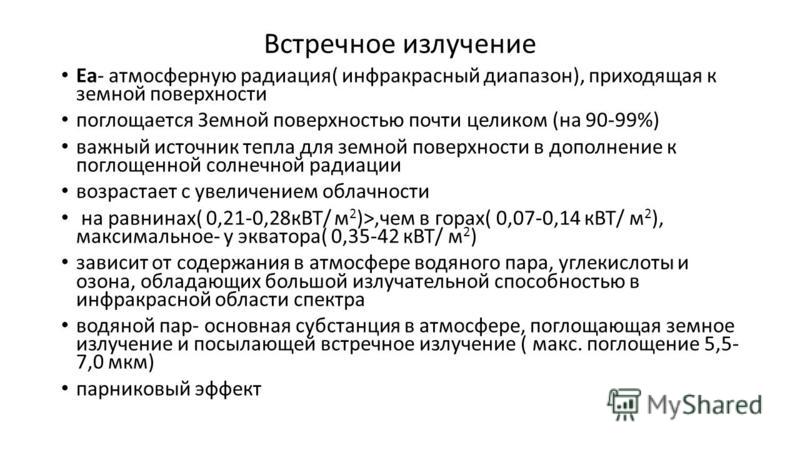
Effective radiation The difference between the intrinsic radiation of the earth’s surface and the atmospheric radiation of the atmosphere, E e E e = E s - E, is the net loss of radiant energy and, consequently, heat from the earth’s surface at night, cloudy weather is much less than in a clear earth’s surface at medium latitudes radiation about half the amount of heat it receives from absorbed radiation.
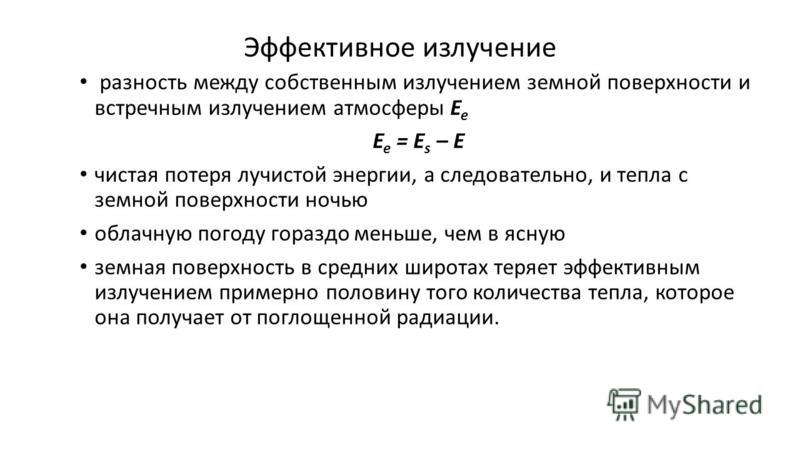
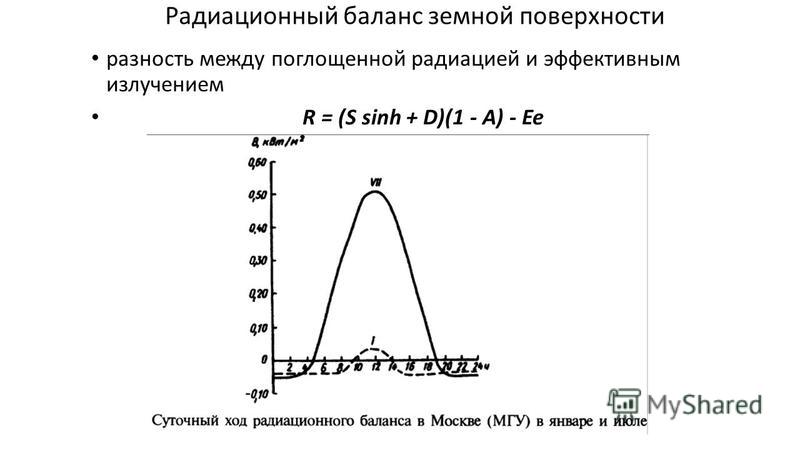
Questions for review 1. What is the solar constant and what does it depend on? 2. What is thermal and radiative equilibrium of the Earth? 3. What is called direct solar radiation? 4. How is solar radiation absorbed in the atmosphere? 5. How is it common in meteorology to subdivide electromagnetic radiation? 6. What substances are the most powerful sinks? 7. How is the dispersion process in the atmosphere determined? 8. What does scattering depend on? 9. What phenomena are associated with scattering of radiation? 10. What characterizes and what determines the daily and annual rate of direct radiation? 11. What is total radiation? 12. What is the surface albedo? 13. What gases create the greenhouse effect? 14. What factors depends on the counter-radiation? 15. How does the radiation balance change during the day?

Send your good work in the knowledge base is simple. Use the form below.
Students, graduate students, young scientists who use the knowledge base in their studies and work will be very grateful to you.
Posted on http://www.allbest.ru/
Introduction
The need to find the atmospheric radiation balance arises in many problems of climate modeling, weather forecasting, impact assessment human activities. One of the main problems arising in the numerical simulation of atmospheric radiation is associated with the presence of a large number of molecular absorption lines, which makes it very difficult to calculate the integral spectral characteristics of the radiation. The atmosphere is not optically thin or optically thick for all parts of the spectrum at the same time.
The sharply changing probabilities of absorption of quanta in nearby energies lead to a complex law of spatial attenuation of the integrated radiation intensity, which differs markedly from the exponential one. The emission spectrum correlates with each absorption resonance. The main transmission of radiation occurs in the wings of the lines. In addition, there is considerable variability and non-uniformity in height of the concentrations of absorbing and scattering components of the atmosphere.
At present, the efforts of experimenters, theorists and calculators have accumulated a large amount of spectroscopic data on absorption cross sections in lines of atmospheric gases and small impurities, as well as data on the scattering and absorption of radiation by cloud particles and atmospheric aerosols. Information on absorption cross-sections is compiled into computer data libraries, which facilitates its refinement and, most importantly, significantly increases the availability of information for use. For example, the HITRAN-92 databank in the range from 40 cm-1 to 22650 cm-1 contains parameters of approximately 700 thousand molecular absorption lines of 32 atmospheric gases, taking into account the different isotopic composition of molecules (altogether with isotopes. Sun radiation atmosphere spectrum
Atmospheric radiation
Radiation in the atmosphere is the electromagnetic radiation of the Sun, which propagates at a speed of 300,000 km / s. Its components are visible light and gamma rays that are invisible to the eye, X-rays, ultraviolet, infrared rays, radio waves. The sun is the main source of heat and light for the earth.
The radiant energy of the Sun turns into heat partially in the atmosphere itself, but mainly on the earth's surface. It heats the upper layers of the soil and water, and from them the air. The heated earth's surface and the heated atmosphere themselves emit invisible infrared radiation into outer space and are cooled.
The radiation of the Sun, which receives the surface of the Earth, can be divided into direct, diffuse and absorbed. This is due to its changes when passing through the atmosphere.
Direct solar radiation comes to the earth's surface directly from the solar disk in the form of a beam of parallel rays. The influx of direct radiation is characterized by intensity - the amount of radiant energy entering the surface perpendicular to the sun's rays. The intensity of the solar radiation flux at the upper atmosphere with the Earth’s average distance from the Sun is called the solar constant. According to the latest data, it is equal to 1.353 kW / m 2.
On average, for each square kilometer of the earth’s surface there are 4.27 × 10 16 J of solar radiation per year.
To obtain such a quantity of heat artificially, it would be necessary to burn more than 400 thousand tons of coal. Over the year, the earth’s surface receives almost 250 times more energy from the Sun than all the power plants in the world produce. At the same time, the solar radiation reaching the Earth is less than two billionths of a percent of the total solar radiation. We understand how significant this amount of energy is when we are witnessing the rapid melting of snow on a warm day, the rapid evaporation of moisture after rain, wind power during a storm or the madness of a sea storm. All these processes occur under the influence of the sun.
On the way to Earth, a small part of the solar radiation is absorbed by the atmosphere. The absorption is selective, because different gases absorb radiation differently. Nitrogen and oxygen absorb only ultraviolet waves. A stronger absorber is ozone. Intensively absorbs radiation in the infrared region of carbon dioxide. The main absorber in the atmosphere is water vapor, concentrated mainly in the lower part of the troposphere. Clouds and atmospheric impurities also absorb solar radiation. Thanks to the phenomena of absorption, the average air temperature is +14 ° C, whereas in the case of the absence of the atmosphere, it was 6-22 ° C. And this means that the Earth would turn into a dead ice-stone desert.
In general, 15-20% of solar radiation is absorbed in the atmosphere. Absorption varies with time depending on the content of absorbed substances in the air (primarily water vapor and dust), as well as the height of the Sun above the horizon, as this changes the thickness of the air through which the rays pass.
The surface temperature of the Earth averages 15 ° C (288 K). Having such a temperature, the Earth emits mainly long-wave infrared (thermal) radiation into the atmosphere. The wavelength for which the maximum energy falls is 10 μm (Fig. 1.4).
The atmosphere absorbs a significant part of the long-wave radiation of the earth's surface. The main absorbers of long-wave radiation are carbon dioxide (C0 2) and especially water (H 2 0), since there is a lot of water in the atmosphere. Clouds consist of liquid (drops), solid (crystals) and gaseous (water vapor) water. They intensively absorb the long-wave radiation of the Earth, acting as an insulating layer, like the glass walls of a greenhouse. This effect is called the greenhouse effect.
If the night is cloudy, then it is relatively warm. If the sky is cloudless, then part of the energy emitted by the Earth’s surface goes into outer space and the night is cold.
In the daytime, the loss of energy due to long-wave radiation is imperceptible, since it is blocked by incoming solar energy. Clouds can absorb, reflect and emit longwave radiation. The atmosphere itself also emits longwave radiation. That part of the long-wave radiation of the atmosphere, which is directed down to the surface of the Earth, is called the radiation of the atmosphere.
Wavelength, micron Fig. 1.4. Earth Surface Radiation and Absorption Bands
Designation for direct and diffuse solar radiation, mainly consisting in the range of wavelengths from 0.17 to 4 microns,
The influence of solar radiation on climate
The emission spectrum of the Sun, observed above the atmosphere of the Earth and at sea level
Solar radiation strongly affects The earth only in the daytime, definitely when The sun is above horizon. Also, solar radiation is very strong near polesin the period of polar days, when the sun even at midnight is above the horizon. However, in the winter in the same places the Sun does not rise above the horizon at all, and therefore does not affect the region. Solar radiation is not is blocked clouds, and therefore still arrives on Earth (with the direct location of the Sun above the horizon). Solar radiation is a combination of the bright yellow color of the sun and heat, heat passes through the clouds. Solar radiation is transmitted to Earth by radiationrather than method thermal conductivity.
The amount of radiation received heavenly bodydepends on the distance between the planet and star - when the distance is doubled, the amount of radiation coming from the star to the planet decreases fourfold (in proportion to the square of the distance between the planet and the star). Thus, even small changes in the distance between the planet and the star (depending on eccentricity orbits) lead to a significant change in the amount of radiation entering the planet. The eccentricity of the Earth's orbit is also not constant - over the millennia it changes, periodically forming almost perfect a circle, sometimes the eccentricity reaches 5% (currently it is equal to 1.67%), that is, in perihelion The Earth now receives at 1.033 more solar radiation than in aphelia, and with the greatest eccentricity - more than 1.1 times. However, much more strongly the amount of incoming solar radiation depends on the changes of the seasons - at present, the total amount of solar radiation entering the Earth remains almost unchanged, but at latitudes 65 S. Sh. (The latitude of northern cities Of Russia, Of Canada) in summer, the amount of incoming solar radiation is more than 25% more than in winter. This is due to the fact that the Earth is inclined at an angle of 23.3 degrees relative to the Sun. Winter and summer changes are mutually compensated, but nevertheless, the gap between winter and summer becomes more and more widespread in terms of the latitude of the observation site. the equator there is no difference between winter and summer. Behind Arctic Circle In the summer, the input of solar radiation is very high, and in winter it is very small. It forms climate on the ground. In addition, periodic changes in eccentricity orbits Earth can lead to the emergence of various geological epochs: for example, ice Age.
|
Average daily amount of solar radiation, kWh / mІ |
|||||||||||||||||
|
Longyear |
Murmansk |
Arkhangelsk |
Yakutsk |
St. Petersburg |
Moscow |
Novosibirsk |
Berlin |
Ulan-Ude |
London |
Khabarovsk |
Rostov-on-Don |
Sochi |
Find |
New York |
Madrid |
Aswan |
|
Literature
1. S. Romanov, A. Trotsenko, B. Fomin Using
2. Numerous methods for describing the transfer of solar radiation
in a scattering atmosphere with strict selectivity
gas absorption. // Preprint IAE them. Kurchatov I.V. 5304/1,
Moscow 1991.
3. Basics of radiation processes in the atmosphere. - L .:
Hydrometeoizdat, 1984.
4. Sevastyanenko V.G. Heat transfer by radiation in real
spectrum. // Diss.Doctor of Physics and Mathematics. - ITAM. Novosibirsk
Posted on Allbest.ru
...Similar documents
The ozonosphere as the most important part of the atmosphere that affects the climate and protects all life on Earth from the ultraviolet radiation of the sun. The formation of ozone holes in the ozone layer of the Earth. Chemical and geological sources of air pollution.
abstract, added on 05.06.2012
Analysis of the possibility of using solar and wind energy in conjunction with a traditional source of energy, as well as autonomous energy supply of sharing solar and wind energy. Comparison for more economical use of wind and solar energy.
examination, added on 03.11.2013
Decreased concentration of stratospheric ozone. What is the ozone hole and the causes of its formation. The process of destruction of the ozonosphere. Absorption of ultraviolet radiation from the sun. Anthropogenic pollution of the atmosphere. Geological sources of pollution.
presentation added on 11/28/2012
The composition and structure of the atmosphere. The main sources of heat, heating the earth's surface and the atmosphere and air temperature. Water in the atmosphere, cloud formation and precipitation. Pressure of the atmosphere, winds, their types. Weather and its forecasting. The concept of climate.
abstract, added on 15.08.2010
Causes of fluctuations in the Earth's climate, which are expressed in statistically significant deviations of weather parameters. Dynamic processes on the Earth, fluctuations in the intensity of solar radiation and human activity. World Ocean Level Variability.
presentation added on 11/01/2017
The effect of ultraviolet radiation on trophic, regulatory and metabolic processes in plants and living organisms. Causes of ozone holes and their effect on human health. The global distribution of the intensity of ultraviolet radiation.
examination, added 01/28/2011
Sources of radioactive contamination. Environmental problems thermal energy and hydropower. Tidal power plants and their environmental assessment. History of the use of wind energy. Environmental assessment of the use of radiant energy of the sun.
abstract, added on 12/02/2014
Gases that are part of the atmosphere; their percentage in the atmosphere and their lifetime. The role and importance in the life of various ecosystems of oxygen, nitrogen and carbon dioxide. Ozone protection of living organisms from harmful ultraviolet radiation.
abstract, added 03/27/2014
The degree and nature of the negative effects of radiation on the health of living organisms. Types of radiation doses: exposure, absorbed, equivalent and effective. External and internal natural exposure. Radiation level in the Chernobyl NPP area.
presentation added on 04/09/2014
Use of water resources. Water pollution. Hydrosphere - water shell of the Earth, including oceans, seas, rivers, lakes, groundwater and glaciers, snow cover, as well as water vapor in the atmosphere. Distribution of water masses in the Earth’s hydrosphere